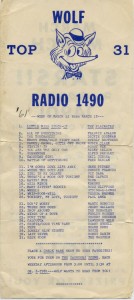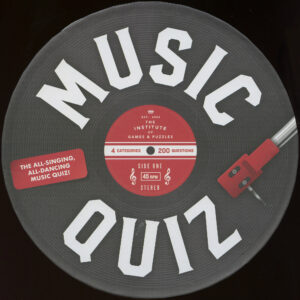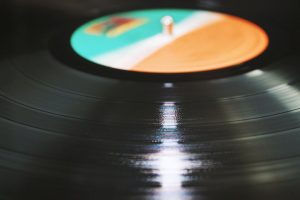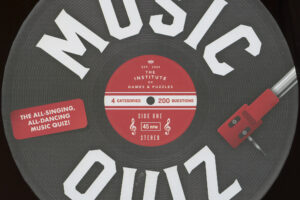Look, I’ve always prided myself on having somewhat eclectic taste in music. But as cool as I have always tried to be, I gotta be honest, when it comes to music I’m really a nerd, if not a stone cold one.
I’m the kind of geek, after all, who grew up kneeling at the altar of pop music at a time when pop DJs were king and their kingdom was the Land of Top 40 radio. Hard rock, electronica, new age and all other hybrid forms of music came to me long after I’d already drunk the Kool Aid and consumed a lifetime’s worth of pop music, station jingles and Top 40 radio.
After all, where else but Top 40 AM radio could I have gone in the 1960s to sample almost every musical style under the sun, from folk, funk, soul, reggae, country and bluegrass to instrumentals, easy listening, show tunes, acid rock, swamp rock, psychedelic rock, early metal, swing, bubblegum, pre-punk garage, power pop and the Great American Songbook – all at the same time and place?
Where else but Top 40 radio were all those styles being lumped together and billed as simply “pop?”
And where else were some of those styles being played on the same day and on the same station, many times back to back within in the very same hour?
Let me tell you a quick story. When my middle sister was born, I was not even two years old yet. And to keep me occupied while giving herself some measure of relief from having a pair of toddlers bounding around the house, my mother told me years later that one day she decided to place a small clock radio next to my crib as something of an electronic baby sitter.
It wasn’t long before I was blowing off my afternoon naps and, instead, spent those two hours listening intently as that little clock radio next to my crib played one 45 after another. In time, I apparently taught myself to lean over the railing and with my right thumb move the tuner dial on that old brown GE clock radio of mine back and forth between one of two Top 40 stations, WNDR, at 1260 on the AM dial, and WOLF, just a half a turn away at 1490.
The year was 1958, and as it turns out that three-year old kid would spend the bulk of the next decade and a half switching back and forth between those two stations, making constant value decisions on which of them was playing the better song.
So while yours truly may not have grown up to become a musician, a musical expert, or hell, even musically literate, I did develop very early on a clear understanding of what I liked musically and what I didn’t.
What’s more, I cut my musical teeth during Top 40’s glory days (those days during which the format was being driven almost exclusively by independently owned stations employing legions of young, rowdy, music-loving, risk-taking and entirely autonomous DJs, who were often a local kid who’d grown up, gotten a job with the local station, and subsequently found himself empowered to play what he felt, when he felt like it). So I spent my formative years not only embracing the wildly eclectic nature of 60s-era Top 40 fare, but passing judgment on literally tens of thousands of songs released as singles by labels large and small, day after day, week after week, for the entire run of the decade.
Make no mistake, however; this list is not my attempt to show off my depth of my knowledge of 60s music or pop culture, or to be hip, or cool, or even contrarian. Just the opposite, in fact. What follows are some of the cheesiest and corniest songs you’d ever want put an ear to.
 Yet, there are some real nuggets here too. And all of them were hand picked by me because they all meant something to me – still do, as a matter of fact – and all have, at least in my mind (and perhaps just as importantly), managed to stand the test of time and escape the perils of overexposure that destroyed so many otherwise mythic tunes from my youth. Call it death by oldies radio.
Yet, there are some real nuggets here too. And all of them were hand picked by me because they all meant something to me – still do, as a matter of fact – and all have, at least in my mind (and perhaps just as importantly), managed to stand the test of time and escape the perils of overexposure that destroyed so many otherwise mythic tunes from my youth. Call it death by oldies radio.
This list is, in other words, an entirely subjective exercise in memory and personal taste, and what follows is nothing more than one man’s honest reflection on one small but meaningful part of his life.
(And as someone coming off a months-long battle with Stage IV throat cancer, I have to admit there is something about going toe to toe with a tumor that makes one reflect on life and things held dear in a way that goes beyond simple posturing — much less the merely intellectual, scholarly, hypothetical or, most egregious of all, cool for cool’s sake.)
Before we get to the list, let me detail why certain songs did not receive consideration and were not included. You won’t find, for example:
Pop singles that, as I mentioned above, have been criminally overexposed by the worst thing to happen to the music of my life; oldies radio
(Van Morrison’s Brown Eyed Girl, Stones’ Satisfaction, Monkees’ I’m a Believer, Aretha Franklin’s Respect, Turtles’ Happy Together, Hit the Road, Jack by Ray Charles, etc., etc., etc).
Onetime beloved singles that have been almost criminally hi-jacked by wedding planners, Hollywood producers, Madison Ave hacks, marketers, hucksters, corporate suits, TV execs and countless other musical agnostics
(Etta James’ At Last, Righteous Brothers’ Unchained Melody, Steppenwolf’s Born to Be Wild, etc.)
Late-60s singles released during the early days of AOR radio that don’t pass the sniff test and feel more like album cuts than honest-to-god 45s.
(Led Zepplin’s Whole Lotta Love, Cream’s Sunshine of Your Love, Buffalo Springfield’s Nowadays Clancy Can’t Even Sing)
Fabulous country singles that never crossed over onto the pop charts (though easily could have, and maybe even should have)
(Merle Haggard’s Mama Tried, Jim Ed Brown’s Pop a Top, Marty Robbins’ Big Iron)
Huge, iconic smash hits that, frankly, never moved me all that much to begin with
(Beatles’ Hey Jude, Foundations’ Build Me Up Buttercup, Stones’ Jumpin’ Jack Flash, I Feel Good by James Brown)
Album cuts I truly loved that were never released as singles
(Beatles’ Lovely Rita and A Day in the Life, It’s a Beautiful Day’s Hot Summer Day, Wind by Circus Maximus)
And last but not least, one particular song that – although a great record, a tune written and recoded in the 60s, and a side that achieved Top 40 success – for purposes of this list was not released as a single until nearly two decades later and was, therefore, excluded on a technicality
(Nina Simone’s Feeling Good)
Here’s what you will find: 300 of my favorite songs to hit the charts between the years 1960 and 1969, recordings that I have listed from #1 to #300 in a very loosely knit reverse order (bottom to top, presented in ten separate groups of 30 each) that still sound as fresh and new to me today as they did roughly a half century ago when I first heard them, and 300 often inconsequential pop recordings that have somehow maintained their ability to stir something deep within me.
Because above all else, what these 300 songs represent are 300 tiny shards of personal memory that many years ago not only helped turn me into a music lover, but in many ways helped me become the man I would eventually grow up to be. What follows, in other words, are 300 moments of pop music greatness or near-greatness which helped shape me as a person and with which I maintain a deep, abiding and highly personal relationship.
Enjoy, and I hope you’ll forgive this rather lengthy intro. I hope too that you’ll someday share your list with me – regardless of how long (or short) it is, regardless of how cool (or un-cool) it is, and regardless of what decade in the history of the American popular song your list (and/or your musical heart) chooses to call home.
271. Ask Me Why
Beatles
1963
This Lennon composition remains, arguably, the only Beatle original ever released as a single that seems to celebrate the safe and predictable thing the popular song had been before the seismic release of I Want to Hold Your Hand, while giving nary a clue as to the stunning extent to which pop music, if not all of Western culture, were about to change forever.
272. Say I Am
Tommy James and the Shondells
1966
Never a big hit for a band that seemed to churn out hits like they were rolling off an assembly line. But I’ve always loved not only the rawness and under-produced, low-tech and demo-like quality of this recording (which was co-written by George Tomsco, guitarist extraordinaire for Jimmy Gilmer and the Fireballs), but the fact that to this day I somehow still have only heard it maybe two dozen times in my life.
273. (The Best Part of) Breaking Up
Ronettes
1964
I realize I’m in a distinct minority here, but even before the latter would end up being played to death by oldies stations across the country, I loved this lesser Ronnie Spector hit much more than its two more popular, more lionized and far more critically lauded stable mates, Be My Baby and Baby I Love You.
274. Wild One
Martha and the Vandals
1963
Motown’s answer to Leader of the Pack, released during the early days of the 60s’ biker craze, this underrated little gem is just one more reason why I still believe that while the Supremes may have harvested Berry Gordy’s most intensive star-making efforts, it was Martha and the Vandellas who were blessed with his label’s most powerful and timeless songs.
275. Angela Jones
Johnny Ferguson
1960
I probably heard this fringy, country-tinged hit a handful of times as a five year old kid, and yet somehow managed to carry around its infectious 14-note hook in my id for the next half century, during which it would find its way into my consciousness at the strangest times; quite often – get this – while I was on the putting green during a round of golf. But I never realized the catchy melody that would regularly pop into my head as I bent over a slippery downhill six-footer came from a real-life song until I was researching this list a few weeks ago and looked up composer John D. Loudermilk. And lo and behold, there it was. And now, here it is.
276. I Can Never Go Home Anymore
Shangri-Las
1965
No desert island jukebox of 60s vintage singles would be complete without at least one overwrought, overproduced and emotionally overflowing Shadow Morton teenage opus. I chose this one, if only because every time I hear it the schoolboy in me still get a little tingle in his nether reaches every time he hears lead singer Mary Weiss – who at that point was just a 17-year high school kid herself (with thick, horned-rimmed glasses, no less) – scream out, “Mama!!!”
277. Call Me Lightning
Who
1968
Make no mistake; I love where Peter Townsend eventually herded his band mates and I take a back seat to no one in my admiration for the Who’s bold-faced artistry and constant willingness to break new ground. But never forget that before the lads became an FM staple they were one hell of a singles band, as evidenced by such diverse little gems as Happy Jack, My Generation, Magic Bus, I Can See for Miles and, in particular, this one – which, frankly, has always been my personal favorite.
278. I Can’t Stop Dancin’
Archie Bell and the Drells
1968
One can argue whether Kenny Gamble, Leon Huff and The Sound of Philadelphia were more important to Archie Bell, or the other way round. What cannot be argued is that Gamble and Huff plucked Bell out of obscurity in 1968 and recorded two fabulous sides with him, the first of which, Tighten Up (which Bell composed himself), eventually suffered the slings and arrows of overexposure, while the latter (which Gamble and Huff penned), found its way under the oldies radar and was able to retain its freshness, power and infectious enthusiasm decades later.
279. I Don’t Wanna Hear It Anymore
Dusty Springfield
1969
I once had Dusty in Memphis in my car’s multi-CD player for over a year. And in that time I realized that for all its greatness as an album, Springfield’s masterwork doesn’t really contain any great individual songs (including the played-to-death Son of a Preacher Man), except one; this melancholy and slightly eerie Randy Newman ballad. When it was released as a single it tanked, but it has nevertheless retained its power to blow me away and I could hear it (and frankly have heard it), day after day, week after week, for months on end and never come close to saying, “Uncle.”
280. Funky Street
Arthur Conley
1969
The succession of soul chestnuts that hit the pop charts late in the decade was in retrospect an almost otherworldly embarrassment of riches. And while this terrific little finger popper, which was recorded at the legendary FAME Studios in Muscle Shoals and produced by another R&B legend, Tom Dowd, may have no better or worse than so many of its contemporaries, it has utterly fallen through the cracks of time and is almost unknown as you read this now.
281. Bowling Green
Everly Brothers
1967
By the time this one was released in the heart of the Summer of Love, the brothers were considered little more than dusty relics from a bygone era. As a result, the last single the Kentucky-born duo released to crack the Hot 100 would rise no higher than #40. But it’s my favorite of theirs, and by a wide margin. (In fact, hearing the song’s bridge even now can bring me to my knees and make me beg for mercy). What’s more, when 80s one-hit wonder a-ha (Take On Me) did one final concert in their native Norway, this was the song they did for an encore. Go figure.
282. King of the Road
Roger Miller
1964
Cool is as cool does. And growing up even as a nine year old, I knew cool when it heard it. And in the spring of 1964, this Roger Miller crossover monster was all that and a bag of donuts. Still is, in fact – especially the third verse when the song changes key and ups the coolness ante for anyone who dares follow.
283. Unwind
Ray Stevens
1968
I never much cared for Ray Stevens and his largely unfunny, listen-to-them-once-and-move-on novelty tunes. But in 1968, out of the blue Stevens released an album from which two straightforward singles were spawned; Mr. Businessman and this terrific little nugget, neither of which were any more than fringe hits, but both of which made social statements to varying degrees, both of which reached inside my young mind and made it question some level of accepted wisdom, and both of which found their way onto my desert island jukebox.
284.
98.6
Keith
1967
In the winter of 1967, for Christmas that year my parents gave me this 45, along with about a dozen or so others and six full-length albums that had been recommended to them by the guys behind the counter at Gerber Music (Supremes a Go-Go, Buffalo Springfield Again, The Rascals Groovin’, Hums of the Lovin’ Spoonful, More of the Monkees and Along Comes…the Association). That deliciously eclectic collection of vinyl would turn out to be the greatest Christmas present I ever received in my life.
285. I’m Alive
Hollies
1965
I’d like to point out that there are a few of us out here who feel that as beautiful as Graham Nash and David Crosby’s voices were in harmony, their harmonies still didn’t stir the soul or make the hairs rise on the back of one’s neck the way Nash and his former jingle-jangle mates Allan Clarke and Tony Hicks did when the Hollies stretched their vocal muscles and transformed otherwise ordinary pop tunes into something else entirely.
286. People Get Ready
Impressions
1965
Sit down with me some night, we’ll crack open a bottle of aged brown liquor, and I’ll detail for you my deep-rooted man-crush on Curtis Mayfield and my gospel belief that he was one of the most sensitive, talented, soulful, overlooked and under-appreciated composers, lyricists, singers and guitarists in the history of American music – not to mention one of the precious few performers from the rock and roll era who truly earned the term, “artist.” And revisiting this awe-inspiring, almost chill inducing pop spiritual some three decades after it was first released was the thing that first opened my mind to the greatness of both the man and his music.
287. Fever
McCoys
1965
Yeah, Hang on Sloopy was a monster hit for these guys, but I’ll take their minor-key rendering of Peggy Lee’s timeless and bluesy classic, if only for the ferociously cool little “Baby turn on your love light…” thing the four small town Hoosiers do at around the two minute mark.
288. I Will Always Think About You
New Colony Six
1968
Like so many kids in the Northeast and Midwest, I often learned what was trending on the charts by waiting each day for the sun to set, the local stations to fade, and the 50,000-watt clear-channel superpowers out of Chicago to assume control of the nighttime skies. It was then, thanks to DJs like Larry Lujack and Dick Biondi of WLS and WCFL, that I could turn on my radio, tune the dial oh-so carefully, and learn about (and often hear live) the Windy City’s exciting new breed of rock bands, the Buckinghams, Cryan’ Shames, Ides of March, American Breed, Shadows of Night, and my personal favorite, the New Colony Six.
289. The Cheater
Bub Kuban & the In Men
1966
There was something hopelessly cheesy and yet tragically hip about both this song and the eight-piece hybrid rock band/cocktail lounge outfit out of St. Louis that recorded it; kinda like a leisure suit worn with just enough swagger, confidence and tongue-in-cheek moxie to make that clothing choice seem, I don’t know, edgy.
290. Make Me Your Baby
Barbara Lewis
1965
It should come as no surprise that this little beauty was co-written by Helen Miller and arranged by Artie Butler, two people who cut their teeth in the tiny cubicles and cramped studios of Aldon Publishing in New York’s famed Brill Building. After all these years, the song retains that early 60s Tin Pan Alley feel, which is, I guess, as good a reason as any for it to make the cut and earn a spot on my list.
291. Do the Freddie
Freddie and the Dreamers
1965
Laugh all you want, but remember this is my jukebox and I’ll be the one living on that god-forsaken island for god knows how long. No, this isn’t a great song, nor was it ever. But it was a huge hit in the early days of the British Invasion and (probably because you never hear it anymore) to behold Freddie Garrity and his over-the-top vocals today, along with this single’s energetic production, is to realize that if you had ever wanted to build a time capsule to capture the hope, wide-eyed optimism and in many ways utter naiveté of the still rosy-cheeked America of 1965, this soon-to-be-forgotten 45 wouldn’t have been a half bad place to start.
292. This Town
Frank Sinatra
1967
Late in his career, the aging icon seemed to record two types of songs; honest, unflinching, and perhaps slightly autobiographical ones (It Was a Very Good Year, That’s Life, Cycles); and ones that were feeble, often awkward attempts to remain relevant (Mrs. Robinson, Don’t Sleep in the Subway, Bad, Bad Leroy Brown). But every now and then Ol’ Blue Eyes would break the mold and remind all of us of his astounding interpretative powers as a singer by placing his stamp squarely on a fresh, new original; like this ballsy, brassy Billy Strange-arranged number written specifically for him by his daughter Nancy’s frequent collaborator and resident cosmic cowhand, Lee Hazelwood.
293. Keep Searchin’
Del Shannon
1964
While I absolutely loved this song from the very first time I heard it (and considered it vastly superior to the era’s other “follow the sun” tune; that winsome ballad by the Beatles), it would be decades before I would come to fully understand both the greatness and the profound and lasting influence of Del Shannon, one of the most criminally under-appreciated figures in the history of 20th Century pop music.
294. Spooky
Classics IV
1967
As a kid, I’m not sure what drew me more to this tune, Dennis Yost’s raspy and soulful rendering of its playful lyrics or the record’s wildly infectious hook, fueled by James Cobb’s simple yet deep, rich, and full-bodied guitar (not to mention that power strumming of his, that would utterly define the sound of his next group, the Atlanta Rhythm Section). Tell you what; let’s call it a draw.
295. The Look of Love
Lesley Gore
1964
For my money, just maybe the best record Gore ever made. This is not the Bacharach/David tune, but a little gem written by Jeff Barry and Ellie Greenwich and produced by the incomparable Quincy Jones (who gave the singer’s paper-thin voice extra oomph by double-tracking her lead vocals). By all rights this minor hit should have climbed much higher on the charts than #27, but then again by December of ’64 the British Invasion was in full bloom and most artists on this side of the pond were in the process of discovering they couldn’t fall out of a boat and hit water.
296. Venus in Blue Jeans
Jimmy Clanton
1962
Let’s be fair, while the British Invasion was clearly a much needed a shot in the arm, Top 40 radio was hardly a wasteland before I Want to Hold Your Hand exploded onto the airwaves. There was the fertile folk scene in Greenwich Village, Southern California’s emerging surf sound, Motown, Tin Pan Alley, and all that high-energy, Creole-inspired fare rising up from New Orleans. What was bad, at least for some of us, was so much of that white-boy-in-a-pompadour crap spewing out of Philly. But every once in a while one of those toothy, teen idol types made a record that, somehow, didn’t suck. Case in point; this little gem by a slightly doughy teenage crooner originally from, of all places, Baton Rouge.
297. The Night Has a Thousand Eyes
Bobby Vee
1963
Speaking of good looking white boys with big, stiff, vertical hair and songs that didn’t suck, Bobby Vee was one of those early 60s cardboard cutouts who actually put together a series of hits that, truth be told, have held up pretty darn well. And the best of those, not to mention my personal favorite of all those teen crooner hits of the period, was this catchy and melodic finger snapper – which, should you be wondering, had nothing to do with the film noir thriller that carried the same title, starred Edward G. Robinson, and was released as a B-movie some 15 years earlier.
298. (I Had) Too Much to Dream Last Night
Electric Prunes
1966
Almost as soon as the decade ended, a lot of the era’s psychedelic hits and misses were immediately (and thankfully) put out to pasture and never heard from again. But this fuzzy little kernel of attitude, reverb, feedback and love hangover – which sounds to this day like a mash-up of pre-punk garage and trippy, post-Sgt. Pepper’s psychedelia – still has the ability to somehow bring home the bacon.
299. Do You Wanna Dance?
Beach Boys
1965
In their long and glorious history the boys from Hawthorne clearly released meatier and far more musically significant sides than this twice-removed cover of an old Bobby Freeman hit. But there has always been something about this recording’s raw energy, its twangy twin surf guitar leads, and its unabashed and unapologetic sense of joy (along with, of course, the fact Brian chose not Carl or himself to sing lead, but middle brother Dennis) that has always kept it near and dear to my heart.
300. Enter the Young
Association
1966
A year later, Break on Through, the very first cut on the very first Doors album, would symbolically shatter an invisible wall and usher in a bold new era of pop music, if not an entire American subculture. In my 12-year old suburban sort of way, that’s what this tune – Side A/Song One of the first album I ever opened and played – would become for me; a musical portal into self-discovery and my very own theme song as I took those wobbly first steps on the long and winding road to manhood.









